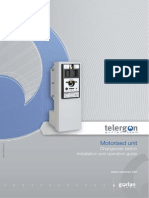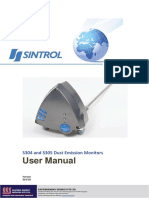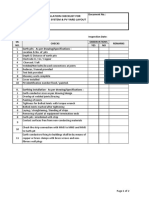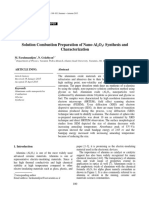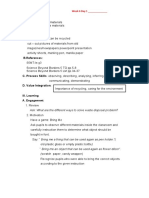BTL6 E500 Manual
BTL6 E500 Manual
Uploaded by
Risha ShettyCopyright:
Available Formats
BTL6 E500 Manual
BTL6 E500 Manual
Uploaded by
Risha ShettyCopyright
Available Formats
Share this document
Did you find this document useful?
Is this content inappropriate?
Copyright:
Available Formats
BTL6 E500 Manual
BTL6 E500 Manual
Uploaded by
Risha ShettyCopyright:
Available Formats
BTL6-E500-M_ _ _ _-E2/E28-KA_ _/KE_ _/LA_ _
english
User's Guide
Balluff GmbH Schurwaldstrasse 9 73765 Neuhausen a.d.F. Germany Phone +49 7158 173-0 Fax +49 7158 5010 Servicehotline +49 7158 173-370 balluff@balluff.de www.balluff.com
BTL6-E500-M_ _ _ _-E2/E28-KA_ _/KE_ _/LA_ _ Micropulse Transducer - Rod Style
Contents 1 1.1 1.2 1.3 1.4 2 Safety Advisory .................... 2 Proper application ................. 2 Qualified personnel ............... 2 Use and inspection ............... 2 Scope ..................................... 2
Safety Advisory 1.4 Scope
Read this manual before installing and operating the Micropulse Transducer. 1.1 Proper application
This guide applies to the model BTL6-E...E2/E28-KA/KE/LA... Micropulse transducer. An overview of the various models can be found in section 6 Versions (indicated on part label) on page 7. Note: For special versions, which are indicated by an -SA_ _ _ designation in the part number, other technical data may apply (affecting calibration, wiring, dimensions etc.).
Function and Characteristics ..................... 3 2.1 Function ................................. 3 3 3.1 3.2 3.3 4 5 5.1 5.2 5.3 5.4 5.5 5.6 6 Installation ............................ 4 Installation variants ............... 5 Transducer, Installation ......... 5 Magnets, Installation ............. 6 Wiring .................................... 6 Startup .................................. 7 Check connections ................ 7 Turning on the system ........... 7 Check output values ............. 7 Check functionality ................ 7 Fault conditions ..................... 7 Noise elimination ................... 7
The BTL6 Micropulse transducer is intended to be installed in a machine or system. Together with a controller (PLC) it comprises a position measuring system and may only be used for this purpose. Unauthorized modifications and non-permitted usage will result in the loss of warranty and liability claims. 1.2 Qualified personnel
This guide is intended for specialized personnel who will perform the installation and setup of the system. 1.3 Use and inspection
Versions (indicated on part label) .............................. 7 6.1 Included in shipment ............. 7 6.2 Available stroke lengths and magnets .......................... 7 7 Accessories (order separately) ............................ 7 7.1 Magnets ................................. 7 8 Technical Data ...................... 8 8.1 Dimensions, weights, ambient conditions ................ 8 8.2 Supply voltage (external) ....... 8 8.3 Output signals ....................... 8 8.4 Overvoltage protection .......... 8
The relevant safety regulations must be followed when using the transducer system. In particular, steps must be taken to ensure that should the transducer system become defective no hazards to persons or property can result.
english
BTL6-E500-M_ _ _ _-E2/E28-KA_ _/KE_ _/LA_ _ Micropulse Transducer - Rod Style
2 2.1
Function and Characteristics Function The torsional wave arriving at the end of the waveguide is absorbed in the damping zone. The wave arriving at the beginning of the waveguide creates an electrical signal in the coil surrounding the waveguide. The propagation time of the wave is used to derive the position. This is output as a current value and has rising characteristics, Fig. 2-1. This process takes place with measuring high precision and repeatability within the stroke range defined as nominal stroke length. When there is no magnet located in the nominal stroke range, a signal is output as an error indication. At the rod end is a damping zone, within which no reliable signal is available, but which may be entered by the magnet. The electrical connection between the transducer, the controller and the power supply is via a cable or leads. Dimensions for installing the Micropulse transducer: Fig. 3-1.
The transducer contains a tubular waveguide enclosed by an outer stainless steel rod. A magnet attached to the moving member of the machine or to the cylinder piston is moved over the rod and its position constantly updated. The magnet defines the measured position on the waveguide. An internally generated INIT pulse interacts with the magnetic field of the magnet to generate a magnetostrictive torsional wave in the waveguide which propagates at ultrasonic speed.
Output signal
Position of the magnet: 1) in the nominal stroke range 2) no magnet located
Null point
End point
Fig. 2-1: Output signal with rising characteristics
english
BTL6-E500-M_ _ _ _-E2/E28-KA_ _/KE_ _/LA_ _ Micropulse Transducer - Rod Style
Installation mounting surface damping zone
nom. length = measuring range
-KA axial, centric
electrical connection
-1
magnet
13
O-ring support ring E2
10.2 mm thread M4 x 4/6 deep without thread
unusable area not included
E28 8 mm
-KE axial, eccentric max. bending radius (KA/KE) static flexed drag chain 3 x cable 7.5 x cable 10 x cable
13
O-ring support ring -LA axial with leads
12
The assured EMC properties can only be achieved when the BTL6-E500-M...-LA00,3 is completely enclosed in a grounded metal housing.
O-ring support ring Fig. 3-1: Micropulse Transducer BTL6-E500....E2/E28..., dimensions
4 english
BTL6-E500-M_ _ _ _-E2/E28-KA_ _/KE_ _/LA_ _ Micropulse Transducer - Rod Style
Installation (cont.)
Threaded stud DIN 914 M5x8
Fig. 3-2: Micropulse Transducer BTL6-E500....E2/E28..., installation
Threaded stud M5
3.1
Installation variants
Be sure that no strong electrical or magnetic fields are generated in the direct vicinity of the transducer. For horizontal mounting of transducer with stroke lengths greater than 500 mm, the pressure tube should be supported or attached at its end. Be sure that no strong electrical or magnetic fields are generated in the direct vicinity of the transducer. Fig. 3-3. 3.2 Transducer, Installation E2 a = non-magnetizable material b = magnet Fig. 3-3: Installation: at non-magnetizable material
B 13 mm
The smallest permissible distance between magnet ring and rod mounting surface is shown in Fig. 3-1. Essentially the BTL transducer can be attached in two ways in a toleranced hole 48 H8 , whereby sealing is accomplished using the O-ring and support ring supplied: The body of the transducer is fixed in place using 3 M5 threaded studs at 120 spacing.
E28 11 mm
a = magnetizable material b = magnet c = spacer of nonmagnetizable material
Fig. 3-4: Installation: at magnetizable material
english 5
BTL6-E500-M_ _ _ _-E2/E28-KA_ _/KE_ _/LA_ _ Micropulse Transducer - Rod Style
3 3.3
Installation (cont.) Magnets, Installation BTL-P-0814-GR-PAF
Wiring Note the following when making electrical connections:
A magnet is required for each transducer. This must be ordered separately. Fig. 3-5. For mounting the magnet we recommend to use non-magnetizable material. Fig. 3-1.
System and control cabinet must be at the same ground potential. To ensure the electromagnetic compatibility (EMC) which Balluff warrants with the CE Mark, the following instructions must be strictly followed. BTL transducer and the processor/control must be connected using shielded cable. Shielding: Copper filament braided, 85% coverage. The shield must be tied to the connector housing in the BKS connector Pin assignments can be found in Table 4-1.
BTL-P-1013-4R
BTL-P-1014-2R
BTL-P-1012-4R
Fig. 3-5: Spacer (optional) To avoid coupled noise, avoid proximity to high-current lines when routing cable between transducer, controller and power supply. Inductive coupled noise from AC harmonics (e.g., from phase controls) are especially critical, against which the cable shield offers very little protection. Max. cable length 20 m. Longer cables may be used if their construction, shielding and routing prevent noise interference. The cable must be routed strainrelieved.
BTL6-E... Output signal: 4...20 mA 0 V(output) GND DC 10...30 V
cable
GN green GY gray BU blue BN brown
Supply voltage (external):
If there is no magnet within the
BTL6-E500...E2/E28-KA...
4...20 mA 0V GND 10...30 V
GN GY
Controller with analog input
active stroke area, a current of 3.6 mA will be output as an error signal. Table 4-1: Wiring
BU BN
Fig. 4-1: BTL6-E500...E2/E28... with controller
english
BTL6-E500-M_ _ _ _-E2/E28-KA_ _/KE_ _/LA_ _ Micropulse Transducer - Rod Style
5 5.1
Startup Check connections 5.3 Check output values 5.5 Fault conditions
Although the connections are polarity reversal protected, components can be damaged by improper connections and overvoltage. Before you apply power, check the connections carefully. 5.2 Turning on the system
After replacing or repairing a transducer, it is advisable to verify the values for the start and end position of the magnet in manual mode. If values other* than those present before the replacement or repair are found, a correction should be made.
* Transducers are subject to modification or manufacturing tolerances.
When there is evidence that the transducer system is not operating properly, it should be taken out of service and guarded against unauthorized use. 5.6 Noise elimination
Note that the system may execute uncontrolled movements when first turned on or when the transducer is part of a closed-loop system whose parameters have not yet been set. Therefore make sure that no hazards could result from these situations.
5.4
Check functionality
The functionality of the transducer system and all its associated components should be regularly checked and recorded.
To avoid a equipotential bonding - a current flow - through the cable shield, we recommend that putting the control cabinet and the system in which the BTL6 is located at the same ground potential.
Versions (indicated on part label) Supply voltage 5 = DC 10...30 V Electr. connection: KA02: KE02: LA00,3: axial centric with 2 m cable axial eccentric with 2 m cable axial with 0.3 m long leads
BTL6-E500-M0450-E28-KA02
Micropulse Linear Transducer
thinner rod (if applicable) 8 = 8 mm Rod construction, pressure tube 10.2 mm Mounting: Plug flange Nom. length (4 digits): M = metric in mm Interface: E = 4...20 mA
6.1
Included in shipment
6.2
Transducer with short guide incl. O-ring and support ring.
Available stroke lengths and magnets
Stroke length Increment
Part No. BTL6...-E2-
50 ... 1500 mm 5 mm
BTL6...-E28- 50 ... 1016 mm 5 mm
Special lengths on request.
7 7.1
Accessories (order separately) Magnets Magnet BTL-P-1014-2R Dimensions Fig. 3-5 Weight approx. 10 g Housing anodized aluminum Operating temp. 40 C to +85 C Magnet BTL-P-GR-PAF Dimensions Fig. 3-5 Weight approx. 2 g Housing PA Operating temp. 40 C to +85 C
Magnet BTL-P-1013-4R, BTL-P-1012-4R Dimensions Fig. 3-5 Weight approx. 10 g Housing anodized aluminum Operating temp. 40 C to +85 C included in shipment Spacer 8 mm Material POM (Polyoxymethylene)
english
BTL6-E500-M_ _ _ _-E2/E28-KA_ _/KE_ _/LA_ _ Micropulse Transducer - Rod Style
Technical Data
Typical values at DC 24 V, room temperature and BTL6-E500-... with nominal length 500 mm and KA02. Ready to use, full accuracy reached after warm-up phase. With magnet BTL-P-1013-4R, BTL-P-1014-2R, BTL-P-1012-4R or BTL-P-0814-GR-PAF: Resolution typical 7 A, with input filter 27 KHz Sampling rate nom. length < 1300 mm nom. length > 1300 mm 1 kHz 0.5 kHz Humidity < 90 %, non-dewing Protection rating IEC 60529 IP 67 when closed up Shock loading 100 g/6 ms per IEC 60068-2-27 1 Continuous shock 50 g/2 ms per IEC 60068-2-29 1 Vibration 12 g, 10 to 2000 Hz per IEC 60068-2-6 1 (take care to avoid natural resonance of protective ) Pressure BTL6...E2 up to 350 bar BTL6...E28 up to 250 bar when installed in a hydraulic cylinder
1
8.3
Output signals 4 - 20 mA < 4 mA, typ. 3.6 mA
Position signal BTL6-E Error signal BTL6-E 8.4
Non-linearity: nom. length < 500 mm < 200 m nom. length > 500 mm < 0.04 % FS typ.0.02 %FS Temperature coefficient 8.1 typ. 25 m/K
Overvoltage protection
Dielectric strength with respect to housing BTL6-...E2-
500 V DC
Dimensions, weights, ambient conditions page 4 approx. 2.0 kg/m Stainless steel 4404 Stainless steel 4571
BTL6...E28 < 1016 mm 8 mm 0.9 mm
Dimensions Weight Housing Pressure tube nom. length Diameter
Individual specifications as per Balluff factory standard
8.2
Supply voltage (external)
Compatibility tests (EMC Directive): ISO 14982 Agricultural and Forestry Machinery ISO 13766 Earthmoving Machinery ISO 7637-1/2/3 Highway Vehicles EN 12895 Lift Trucks
approx. 200 kN/mm PTFE NBR Operating temp. -40 C to 85 C Storage temp. max. 90 C
E-Moduls Support ring O-Ring
The CE Mark verifies that our products meet the requirements of EC Directive 89/336/EEC (EMC Directive) and the EMC Law. Testing in our EMC Laboratory, which is accredited by DATech for Testing Electromagnetic Compatibility, has confirmed that Balluff products meet the EMC requirements of the following Generic Standards: EN 61000-6-4 (emission) EN 61000-6-2 (noise immunity)
Emission tests: RF Emission EN 55011 Group 1, Class A+B Noise immunity tests: Static electricity (ESD) EN 61000-4-2 Severity level 3 Electromagnetic fields (RFI) EN 61000-4-3 Severity level 3 Fast transients (Burst) EN 61000-4-4 Severity level 3 Surge EN 61000-4-5 Severity level 2 Line-induced noise induced by high-frequency fields EN 61000-4-6 Severity level 3 Magnetic fields EN 61000-4-8 Severity level 4
EN 50121-3-2 Rail applications ISO 11452-5 Electromagnetic field HF, 200 V/m Restrictions: External protection measures must be taken: EN 150121-3-2: (Burst 2kV per EN 61000-4-4): ISO 7637-2 Pulse 5a External buffering measures must be taken: Fluctuations and interruptions in the supply (EN 50155)
english
No. 853 589 -726 E 00.000000 Edition 0707; specifications subject to changes.
BTL6...E2 < 1500 mm 10.2 mm Wall thickness 2 mm
Regulated supply voltage DC 10 ... 30 V < 0.2 Vss Ripple Current draw typical 2 W Inrush typical (Sampling rate 1 KHz) < 80 mA at 24 V DC Overvoltage 36 V Polarity reversal protection max. 40 V
You might also like
- SVP Single Three PhaseDocument7 pagesSVP Single Three PhaseAlin Daniel0% (1)
- Installation And Maintenance Manual JOSLYN P/N 1455-85-M JOSLYN P/N 1455-85-MN Ac Power Arresters 208/120 VAC, 3φ, 4 WIRE, GROUNDED WYEDocument8 pagesInstallation And Maintenance Manual JOSLYN P/N 1455-85-M JOSLYN P/N 1455-85-MN Ac Power Arresters 208/120 VAC, 3φ, 4 WIRE, GROUNDED WYEsrogan2323No ratings yet
- SchwartzDocument25 pagesSchwartzAntónio Oliveira100% (1)
- BFT LIBRA Control PanelDocument10 pagesBFT LIBRA Control PanelAADAFFAFASASNo ratings yet
- R8605B M300 V2Document268 pagesR8605B M300 V2Rinda_Rayna100% (2)
- Axor Drive Service ManualDocument68 pagesAxor Drive Service Manualkratmel100% (2)
- Abc of Power Modules: Functionality, Structure and Handling of a Power ModuleFrom EverandAbc of Power Modules: Functionality, Structure and Handling of a Power ModuleNo ratings yet
- SPE 140463 Marcellus Shale Hydraulic Fracturing and Optimal Well Spacing To Maximize Recovery and Control CostsDocument13 pagesSPE 140463 Marcellus Shale Hydraulic Fracturing and Optimal Well Spacing To Maximize Recovery and Control CostsRanggaNo ratings yet
- MECH 3002 Assignment 2 2017Document3 pagesMECH 3002 Assignment 2 2017John100% (1)
- BTL5 BallufDocument12 pagesBTL5 BallufMargaret DaughertyNo ratings yet
- BFT Libra C MaDocument10 pagesBFT Libra C MamcilNo ratings yet
- FVR - C11S Instruction ManualDocument104 pagesFVR - C11S Instruction ManualMuhammad IqbalNo ratings yet
- Bu6010 GB 0300Document44 pagesBu6010 GB 0300Kadirou BigstarNo ratings yet
- 7 - 5250 - 01880 - 01E NachrüstsatzDocument11 pages7 - 5250 - 01880 - 01E NachrüstsatzEvandro Jva compressoresNo ratings yet
- Instruction Manual - BOOK 3 Electrical Installation: Electromagnetic FlowmetersDocument24 pagesInstruction Manual - BOOK 3 Electrical Installation: Electromagnetic FlowmeterstranstechmuthuNo ratings yet
- MODEL DX3301/ PRO DP/DD/DC 1001 Series: Product ManualDocument11 pagesMODEL DX3301/ PRO DP/DD/DC 1001 Series: Product ManualrodrurenNo ratings yet
- Victron VM 3P75CT Energy Meter PDF enDocument16 pagesVictron VM 3P75CT Energy Meter PDF enRam CaceresNo ratings yet
- Telergon CosDocument20 pagesTelergon CosDicky FirmansyahNo ratings yet
- Installation and Operation Manual: Omslagma00834.Fm Page 1 Friday, March 17, 2006 1:49 PMDocument29 pagesInstallation and Operation Manual: Omslagma00834.Fm Page 1 Friday, March 17, 2006 1:49 PMMuhammet GulbahceNo ratings yet
- Na5 Service Manual Bargraph LumelDocument64 pagesNa5 Service Manual Bargraph LumelCusbac BacauNo ratings yet
- Contactiving Conductivity SensorDocument134 pagesContactiving Conductivity SensorEnmanuel Rosales Carvajál100% (1)
- ABB Control PanelDocument100 pagesABB Control Panelselvamnathan100% (1)
- 667 HB 32900 000Document260 pages667 HB 32900 000Rodrigo Francisco León BarríaNo ratings yet
- User Manual: Eastern Energy Services Pte LTDDocument28 pagesUser Manual: Eastern Energy Services Pte LTDr.viswanathNo ratings yet
- Sylvania srt2223x (ET)Document52 pagesSylvania srt2223x (ET)Roberto Jimenez RojasNo ratings yet
- EcoLAMBDA Instrukcja Instalacji I Użytkowania Wydanie 5.0 enDocument16 pagesEcoLAMBDA Instrukcja Instalacji I Użytkowania Wydanie 5.0 enAlin BeșaNo ratings yet
- R8618a M220Document68 pagesR8618a M220Rinda_RaynaNo ratings yet
- Installation Manual: JY997D33501DDocument3 pagesInstallation Manual: JY997D33501DDon Rodo Delgallagher100% (1)
- Tema1 (1) .0 TKMOD IM 1.13 ENDocument70 pagesTema1 (1) .0 TKMOD IM 1.13 ENxspectroxNo ratings yet
- Delta ManualDocument392 pagesDelta Manualnkapnangluther3099No ratings yet
- WF203 - SM - (ET) SYMPHONICDocument53 pagesWF203 - SM - (ET) SYMPHONICarturo48No ratings yet
- APM802 - User Manual Redundancy Ring Modules - MAN31613604401 - 501 - 601 - 701 - ENDocument18 pagesAPM802 - User Manual Redundancy Ring Modules - MAN31613604401 - 501 - 601 - 701 - ENBrandon AtzNo ratings yet
- CHINA HBTV-3201HD Chassis MSTAR 6U89 PDFDocument36 pagesCHINA HBTV-3201HD Chassis MSTAR 6U89 PDFIvanilto Martins da CruzNo ratings yet
- HAIER 32e2000a Service Manual PDFDocument52 pagesHAIER 32e2000a Service Manual PDFcarlos amaya100% (1)
- Samsung PS43D490A1XZN F83A PDFDocument68 pagesSamsung PS43D490A1XZN F83A PDFoppa BaruNo ratings yet
- EWF2703 TV EmersonDocument57 pagesEWF2703 TV EmersonEriksson Miguel Tapia SolisNo ratings yet
- Man-1078 SigmaCP 24Document24 pagesMan-1078 SigmaCP 24Viddhesh ManjrekarNo ratings yet
- 25pt4622Philips+L7 3A+AADocument48 pages25pt4622Philips+L7 3A+AAWall BrysonNo ratings yet
- L196WTQ-S, BFQ eDocument30 pagesL196WTQ-S, BFQ eadisistemsNo ratings yet
- MAG500-6000 Installation & Fault FindingDocument21 pagesMAG500-6000 Installation & Fault FindinglquickfallNo ratings yet
- Barton Flotrac 308 User ManualDocument16 pagesBarton Flotrac 308 User ManualJose Fernando Davila VigoNo ratings yet
- LG L194WTDocument29 pagesLG L194WTqxbgwhvuNo ratings yet
- LG Flatron l227wtg-Pfs-A Chassis Lm72d SMDocument29 pagesLG Flatron l227wtg-Pfs-A Chassis Lm72d SMxor_45No ratings yet
- Companion 3 SCHDocument30 pagesCompanion 3 SCHRicardo Berbis64% (11)
- Indoor RMU ManualDocument20 pagesIndoor RMU Manualhardeepsingh_08No ratings yet
- JVC HX-Z9 Manual de ServicioDocument66 pagesJVC HX-Z9 Manual de ServicioJosé BenavidesNo ratings yet
- Emerson EWT19S2Document50 pagesEmerson EWT19S2dreamyson1983100% (1)
- Q68RD3 GDocument20 pagesQ68RD3 GJackam kamNo ratings yet
- FX Series User's Manual - Data Communication EditionDocument726 pagesFX Series User's Manual - Data Communication EditionJohn Forbes Nash100% (3)
- Clarion - PP 3097L A PDFDocument34 pagesClarion - PP 3097L A PDFspeedyeduNo ratings yet
- R8059H MBCZ10Document76 pagesR8059H MBCZ10Rinda_RaynaNo ratings yet
- Epcos Thyristor ModuleDocument6 pagesEpcos Thyristor ModuleSanthosh OsNo ratings yet
- Fiber Optics Communication enDocument50 pagesFiber Optics Communication enMinh Đức Phạm TrầnNo ratings yet
- 28LF-92EES: Service ManualDocument92 pages28LF-92EES: Service Manualyomismooo32No ratings yet
- J1939 Gateway™: Installation and Operation GuideDocument27 pagesJ1939 Gateway™: Installation and Operation GuideEmrol2No ratings yet
- Nordac Vector MC PDFDocument64 pagesNordac Vector MC PDFTonino08No ratings yet
- Deltasol Pool: Mounting Connection OperationDocument20 pagesDeltasol Pool: Mounting Connection OperationSunMaxx SolarNo ratings yet
- LG Flatron Monitor l1918sDocument44 pagesLG Flatron Monitor l1918sdadogogaNo ratings yet
- 8510 Wiring Guide: ObjectivesDocument19 pages8510 Wiring Guide: ObjectivesActem PmeNo ratings yet
- Introduction to Power System ProtectionFrom EverandIntroduction to Power System ProtectionRating: 5 out of 5 stars5/5 (1)
- Trilogy of Connectors: Basic Principles and Connector Design ExplanationsFrom EverandTrilogy of Connectors: Basic Principles and Connector Design ExplanationsRating: 5 out of 5 stars5/5 (1)
- Protection of VSD TransformersDocument12 pagesProtection of VSD TransformersGetssy PrathibaNo ratings yet
- Manual de Taller Subaru Impreza 99-01 (Motor)Document233 pagesManual de Taller Subaru Impreza 99-01 (Motor)Jorge RodríguezNo ratings yet
- Safety: Operation and Maintenance Manual ExcerptDocument19 pagesSafety: Operation and Maintenance Manual ExcerptKhairuddin KhairuddinNo ratings yet
- Well Completion (2) Model AnswerDocument4 pagesWell Completion (2) Model Answermissaoui0% (1)
- Walter Lao Russell - Atomic-SuicideDocument300 pagesWalter Lao Russell - Atomic-SuicideJe MaNo ratings yet
- Recommended Maintenance Intervals For Continuous Duty Reciprocating CompressorsDocument8 pagesRecommended Maintenance Intervals For Continuous Duty Reciprocating CompressorsManuel LiñeiroNo ratings yet
- Cementing CalcDocument10 pagesCementing CalcAfief Ma'rufNo ratings yet
- DT SeriesDocument1 pageDT SeriesDaniel TanNo ratings yet
- Buta Market and FeedstocksDocument49 pagesButa Market and FeedstocksChemEngGirl89No ratings yet
- Blast Furnace Tap Hole and Tapping of The FurnaceDocument11 pagesBlast Furnace Tap Hole and Tapping of The Furnaceprashant mishraNo ratings yet
- CS Analytical Coding Interview QuestionsDocument1 pageCS Analytical Coding Interview QuestionsClevin CkNo ratings yet
- Updated Simulation Model of Active Front End Converter: Project Memo AN 01.12.97Document11 pagesUpdated Simulation Model of Active Front End Converter: Project Memo AN 01.12.97bpchimeraNo ratings yet
- Timothy Leary - StarseedDocument12 pagesTimothy Leary - StarseedManuel Pennuto50% (2)
- Air Ejector PAperDocument13 pagesAir Ejector PAperRizwan YounusNo ratings yet
- 4th Biennial Emergy Research ConferenceDocument553 pages4th Biennial Emergy Research ConferencePapapapapapaNo ratings yet
- Calibr Fluke 1550cDocument24 pagesCalibr Fluke 1550cHelvécio OliveiraNo ratings yet
- Manual Operacion 34rstDocument92 pagesManual Operacion 34rstDaniel MondragonNo ratings yet
- 12th Physics SQs Notes For Average Students by Youth AcademyDocument41 pages12th Physics SQs Notes For Average Students by Youth Academyshahsyedaf.sc.imaginativegirl.34No ratings yet
- Handout 5Document14 pagesHandout 5coppernitrateNo ratings yet
- Inventor ARIA Users Manual Aria ENG GRDocument24 pagesInventor ARIA Users Manual Aria ENG GRsakiskalouaNo ratings yet
- Installation Checklist For Earthing System & PV Yard LayoutDocument2 pagesInstallation Checklist For Earthing System & PV Yard LayoutCarla Vietor50% (2)
- TransducersDocument19 pagesTransducersTsihatesfaNo ratings yet
- Solution Combustion Preparation of Nano-Al2o3Document6 pagesSolution Combustion Preparation of Nano-Al2o3mirelamanteamirelaNo ratings yet
- I. Objectives:: B.ReferencesDocument33 pagesI. Objectives:: B.ReferencesKairuz Demson AquilamNo ratings yet
- ITP For Storage Tank According To API650Document5 pagesITP For Storage Tank According To API650Maneesh KumarNo ratings yet
- Chapter 12 Homework: Due: 9:00am On Wednesday, November 11, 2009Document8 pagesChapter 12 Homework: Due: 9:00am On Wednesday, November 11, 2009Chun Ming IpNo ratings yet

















